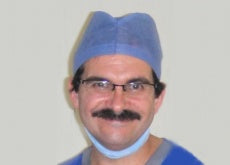
Creating the appropriate instruments for capsulorrhexis by Dr. Luis Guillermo Guerra Trejo
The ophthalmologist and the required instruments form an important team
To achieve better results in ophthalmic surgery, it is often indispensable to have appropriate surgical instruments. An ample level of surgical experience results in the knowledge that the instruments can assist in and facilitate certain steps during ocular surgery. One of the most commonly used instruments are the forceps for capsulorrhexis.
As a surgeon, one looks for the following:
1.- Instruments that pass through increasingly smaller incisions with the goal of minimizing post-operative astigmatism
2.- A pair of forceps that can hold the crystalline capsule firmly
3.- A clear view of the capsule while we have the capsule within the forceps
4.- Instruments that allow us to save on the use of another instrument within the eye
5.- The toothed plate facilitates the grip of the capsule at all times
6.- Instruments that have the appropriate length and curvature, among other requirements

This has obliged companies to develop the instruments which comply with our expectations and which allow us to conduct the same steps within the eye, but through increasingly smaller incisions.
Rumex International Co. has an investigation, design, development and production team by which I was contacted merely a few months ago. That was the moment that I had the pleasure of trying the modified forceps of Kawai and started to use them in my surgical procedures.


After having conducted some 500 surgeries, I can mention the following:
1.- Thanks to their 23g diameter in the body and their 25g diameter on the tip, you can use them for whichever size of incision, which is why they can easily be used in openings of up to 1 mm
2.- The great opening of the forceps allows them to grab the capsule easily
3.- They are so fine at the tip that they make it possible for us to see perfectly what we are doing below the forceps during capsulorrhexis
4.- You save on the use of cystotome and one can start capsulorrhexis without the cystotome. When you enter, I only recommend doing it with the forceps of an angle of 90 degrees with respect to the level of capsulorhexis; so that the apices of the cystotome do not damage the tunnel floor or the corneal tissue, as we often do when using forceps that include cystotome
5.- The toothed plate facilitates the grip of the capsule at all times
6.- I found two ways of conducting capsulorrhexis thanks to its fineness and the thinness of its tip
a)Directly making an incision on the lens capsule with the tips closed, tearing it towards any side.
b)Making a preseptal dissection. In other words, puncturing the lens capsule and opening the forceps to tear it. This is what I finally prefer
7.- I recommend supporting it with the other hand in a way that the index finger serves as a support for the forceps, the reason being that, as the forceps are very thin, it is difficult to control them at first, especially in incisions bigger than 1 mm.
8.- I think that the curvature of the forceps is appropriate, given that it makes it possible for us to handle them in a comfortable manner and that they allow us to reach the lens capsule even in highly myopic eyes. Furthermore, it proves out to be very useful when we are working through incisions of 1 mm, given that this curvature gives us the possibility not to stress the wound by not crashing into the lateral borders when intending to reach the lens capsule during capsulorrhexis.
9.- To increase the service life of the forceps, I recommend to always clean them at the end of the surgical day with the device that the forceps include, which is specifically used for that purpose.

Links on the web on the modified forceps of Kawai
Medical Surgeon from the National Autonomous University of Mexico, Class of 1987-1991
Ophthalmic surgeon graduated from the General Hospital of Mexico Department of Health, Class of 1993-1996
Security in the Naucalpan State of Mexico, where he has been assigned since the year 1998
Fellowship in rapid and safe phacoemulsification in Cerdeña, Italy in the year 2012
Member of the American Society of Cataract and Refractive Surgery
Experience: More than 4500 phacoemulsification surgeries, managing complicated cases, such as subluxated crystalline lenses, congenital cataracts, Morgagnian cataracts, pathological cataracts, microphthalmia, posterior polar cataracts, cataracts and myopia.
Became pioneer in conducting phacoemulsification surgery in the Mexican Institute of Social Security 14 years ago in the State of Mexico
High-volume surgeon, operating 30 patients daily within the Public Insurance scheme Currently conducts only micro-coaxial phacoemulsification with 2.2 and 1.8 mm of incisions. Therefore, the forceps of Kawai, Rumex are his preference for Capsulorrhexis
User of Rumex instruments for 14 years. He acquired the instruments through the recommendation of the brand by his professors. He has checked the quality of the instruments, which he has been using to this day for his surgeries. He has completed a total of more than 4500 surgeries with the instruments. 
